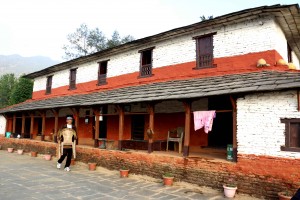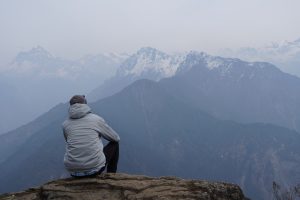The term concrete jungle has been used so often to refer to Kathmandu that I think it has created a wall in the minds of valley’s denizens. Very few people seem to mention – or even remember – the wonderful outdoors that are the hills that encircle the city.
Kathmandu is blessed with wonderfully preserved forested areas that are rich in wildlife. Here are a few that would make for a memorable weekend hike.
Shivapuri National Park & Nagarjun

Photo: Kapil Bisht
Perhaps because Shivapuri is always in sight, it somehow escapes the imagination of the locals.
Shivapuri is no Chitwan, or Bardia. You don’t go in expecting to see tigers, elephants or rhino. On a lucky day, you may see a ratuwa, barking deer. But the woods are food for the jaded senses. You feel the change, the freshness, the revival of something inside as soon as you enter through the gates at Pani Muhan. The shadowy road has a soundtrack of birdsong pouring in from the canopy. A hundred meters or so from the gates, there is that most coveted of things: silence. Whenever that silence is broken, it is by something natural: a brook’s murmur, the scuttling of birds on the forest floor, the sudden crash of a startled animal.
There is one frown-inducing spot on the trail though. Around a bend, the forest cover suddenly disappears and there is a clear view of the city below. You are likely to shake your head and mutter “concrete jungle” before moving on.
Read also: Shivapuri: The Hill of Longing
But the ugliness of the cityscape is forgotten quickly as you walk on in the shady road. For those who are not into long hikes, Nagi Gompa is the place to turn back from.Walking uphill for another couple of hours brings you to Shivapuri’s peak ((2732m). On the way you pass Baghdwar, the place where the Bagmati originates. The peak itself is not something remarkable, but the views of mountains from there are unrivaled from any point on the Kathmandu Valley’s rim.
The Nagarjun hill has one of the best-preserved wildernesses around Kathmandu. It could be a retreat for anyone tired of walking down paved roads under the gaze of high-rises. Dense forests, a steady but easy climb and a monastery at the summit make this an ideal destination for a weekend hike. There are two routes to Jamacho, the name for the summit: one begins north of Swayambhunath and the other is a ten-minute drive north from Balaju Baisdhara Park.
Phulchowki
Photo: Wikimedia Commons
The Phulchowki hill, like Shivapuri, was once a forest set aside for the Rana elites to hunt in. Today, the mountain is the perfect place for Kathmanduites to feed their greenery-starved senses.
Phulchowki is one of the best places for birdwatching in Kathmandu. Species that have all but vanished from other parts of the valley still survive in good numbers here. It is a wilderness with a road, making it a destination for all kinds of visitors from binoculars-toting birders to hikers to motorcyclists.
Read also: Here’s how you can escape Kathmandu, without leaving it!
The trail is also fantastic for mountain biking. Anyone going to Phoolchowki on wheels needs to be careful though, because the road acquires a layer of ice in winter.
If the hike up to the summit is too much for you, you can still get a feel of the outdoors and rich birdlife of the area by visiting the Godavari Botanical Gardens. Calling this garden a little paradise, when you consider how deprived the city is of greenery, is not an exaggeration. Its appeal is simple: being in a place where every inch is taken up by plants.
Champa Devi
Photo: Wikimedia Commons
The hike to the Champa Devi’s shrine is a mini pilgrimage of sorts. You begin at Chalnakhel, on the road to Pharping, and climb steadily until you get to a ridge. From there it’s another climb up to the forested summit. The reward for climbing all the way up there is a scene resembling the paintings on display in curio shops in Kathmandu: small villages, a river, a pond, verdant hills and rising above them, a jagged fence of snowy peaks.
Looking down you notice that there is still plenty of farmland here—the kind of place Kathmandu was in the past. And perhaps there is a moment when you realise that the hike has brought out a side of you that you lost in the concrete jungle. Chances are, you will find it in the real jungles that surround Kathmandu.
Things to Know

The Shivapuri and Nagarjun hills are both part of the Shivapuri-Nagarjun National Park. Entry into and movement within them is limited to daylight hours. Rules apart, it is advisable, especially if you are going in winter, to know the area well. Miscalculations can often mean that you will end up hiking in the dark—a hazard in the hilly terrain and dense forests. Always carry a good flashlight with you and plenty of water when going on a hike in these forests.
There have been several cases of people being mugged in Phoolchowki, so go in big groups if possible. The forest is also in the news for people losing their way and search parties having to go out to find them. Keep to the graveled road to avoid that sort of misadventure.
After the initial scattered houses, there are no houses on the trail to Champa Devi’s shrine. Carry plenty of drinking water and food with you. It’s best to begin the hike there early in the morning to give yourself enough time to complete the taxing climb, rest and return down to the road.
***
Read also
Mountain Retreat in Namo Buddha
The rustic utopia that is Dandagaon
























